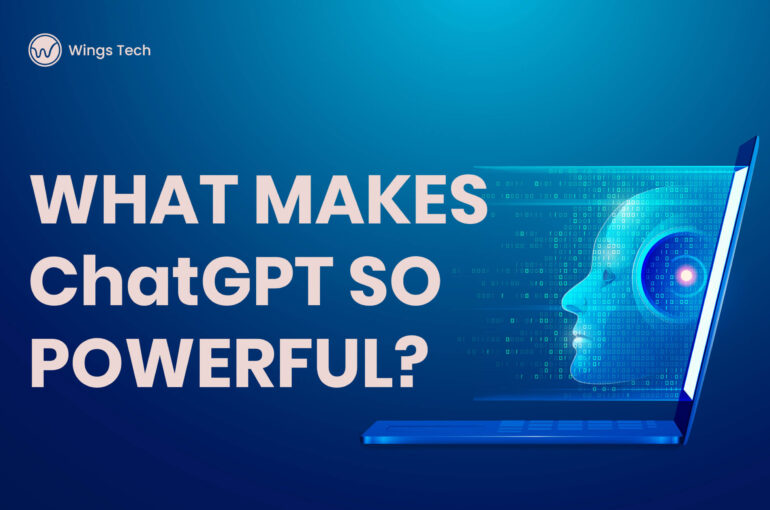What Makes Chat GPT So Powerful

“The question of whether a computer can think is no more interesting than the question of whether a submarine can swim.” – Edsger W. Dijkstra
Dijkstra couldn’t be more right about this. There used to be a time when we used to communicate with computers in a primitive manner. Communication mostly used to be inclined toward us and the output that computers gave was also quite primitive and limited to the technology at the time.
And look at the computers now! It’s like a child that has grown into a teenager who can articulate their thoughts when we talk to them. Yes, you read that right. If we analogize with humans, computers are just in their teenage phase right now. Imagine how superior they will be in their adult phase!
Nowadays, it is becoming less surprising that computers can do things we could not imagine they could do just a decade ago. Artificial Intelligence has surpassed all human expectations concerning its performance. Machine Learning models can now be trained to generate exceptional outputs based on human inputs. At this stage, we can say that computers can do anything that people from previous generations could not even fathom.
The rise of artificial intelligence gave birth to one of the most powerful assets in the arsenal of computer technology: AI chatbot.
AI chatbots are powerful tools that are transforming the way businesses interact with their customers. These digital assistants are designed to mimic human conversation, using natural language processing and machine learning to understand customer queries and provide accurate responses. But they’re not just useful for customer service – chatbots can also help with lead generation, sales, marketing, and even internal operations.
One of the biggest benefits of AI chatbots is their ability to provide a personalized and engaging customer experience. By analyzing customer data and interactions, chatbots can offer tailored recommendations, discounts, and promotions that are relevant to each customer. This not only helps to build trust and loyalty but can also increase sales and revenue for businesses.
Another advantage of AI chatbots is their efficiency. Unlike human customer service representatives, chatbots can handle multiple conversations simultaneously, 24/7. This means that businesses can provide round-the-clock support without having to increase their workforce or extend their working hours. Chatbots can also handle repetitive tasks such as answering frequently asked questions, freeing up human staff to focus on more complex tasks that require human skills and expertise.
Today we will talk about one of the fastest-growing AI chatbots in the world: Chat GPT. We’ll talk about some of the aspects of it that you should know which make ChatGPT so powerful.
What is GPT and How Does It Work?
Did you know that the “GPT” in ChatGPT stands for “Generative Pre-trained Transformer,” which is a fancy way of saying that it’s a machine learning model that uses unsupervised learning to understand and generate natural language?
ChatGPT is like a language prodigy that has read everything on the internet and learned how to speak like a native. It can process massive amounts of text data and generate surprisingly human-like responses. And the best part is that it’s always learning and updating itself based on the interactions it has with users.
To understand how GPT works, it’s important to first understand what machine learning is. Machine learning is a subset of artificial intelligence that involves training algorithms to recognize patterns in data and make predictions based on those patterns. In the case of natural language processing, machine learning algorithms are trained on large amounts of text data to learn how language works and how to generate natural-sounding responses to different queries.
GPT is a specific type of machine learning model that is based on a neural network architecture called a “transformer.” This architecture is designed to process sequential data, such as text or audio, by learning how to relate different parts of the sequence to each other.
The Robust Training
Have you ever wondered how ChatGPT became so smart and knowledgeable? It’s all thanks to the massive amount of text data it was trained on! ChatGPT has read everything from classic literature to modern-day memes, all in the name of understanding and generating natural language.
It’s like the ultimate bookworm, devouring every bit of information it can get its virtual hands on. And the best part is that it’s always learning and updating itself based on the interactions it has with users. So the more you chat with ChatGPT, the better it gets at understanding what you’re saying and responding in a way that’s natural and human-like.
With all that training, ChatGPT has become an expert in natural language processing. It can understand complex sentence structures, recognize idioms and slang, and even detect the nuances of different languages and cultures. And that makes it the perfect language model for a variety of applications, from customer service chatbots to language translation services.
So whether you’re chatting with ChatGPT to get answers to your burning questions or just to have a friendly conversation, you can be sure that you’re talking to an AI language model that’s been trained on the best and brightest of the internet. With its vast knowledge and understanding of natural language, ChatGPT is changing how we communicate with technology and making it easier than ever to connect with others.
The Unbiased Approach
When you’re chatting with ChatGPT, you can be sure that you’re getting a response that’s free from personal biases or beliefs. That’s because ChatGPT’s responses are generated algorithmically, which means that there’s no human interference in the process.
ChatGPT is like the ultimate unbiased friend who’s always there to listen and give advice. It doesn’t care about your race, gender, religion, or political views – all it cares about is providing you with accurate and helpful information.
So whether you’re looking for a quick answer to a question or need some guidance on a complex issue, ChatGPT is the AI language model you can trust. Its responses are based on data and facts, not personal opinions or beliefs. And that means you can have confidence in the information you’re getting and make decisions based on what’s truly best for you.
In a world where personal biases and beliefs can often cloud our judgment and influence the information we receive, ChatGPT is a refreshing change. Its algorithmic approach ensures that you’re getting the most accurate and reliable information possible, without any hidden agendas or biases.
In conclusion, we can say that we have come very far in terms of Artificial Intelligence. The interesting thing about ChatGPT is that the GPT-3 model is trained with 175 billion parameters whereas the next iteration of the bot GPT-4 model is going to be trained with 100 trillion parameters. Just imagine how powerful it will be!
Hope this article helped you comprehend more about ChatGPT and why it is so powerful. To explore more such interesting topics, visit https://www.wingstechsolutions.com/blogs/. Until then see you next time!

















